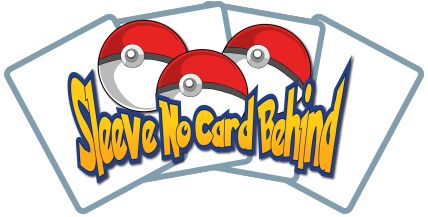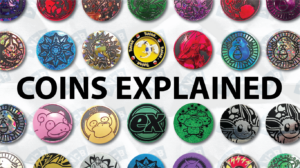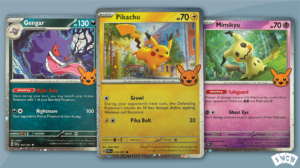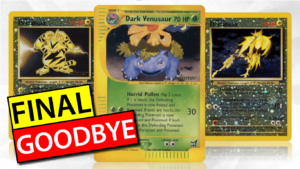How to Identify Fake Yu-Gi-Oh! Booster Boxes (Step-By-Step Guide)
-
By: Oliver Copeland
- Published:
- Last Updated: December 3, 2023
It’s unfortunate that in today’s society, we have to worry about purchasing fake trading cards, but it’s a reality. The realm of fakes can be difficult to navigate unless you possess extensive knowledge in the field. Fortunately, at Sleeve, we’re armed with that expertise. We’re thrilled to present our comprehensive guide on discerning authentic Yu-Gi-Oh! booster boxes from their counterfeit counterparts.
With our crash course, you’ll transition from novice to connoisseur, equipped to confidently identify the genuine product, in no time at all.
Why Buy Yu-Gi-Oh! Booster Boxes?
You already know what a booster box is, so we’ll skip that part! Let’s instead discuss why they are so popular.
For starters, booster boxes are a great deal. 24 packs at a discount is obviously a steal, but there’s a secret thrill when purchasing one. Perhaps it’s the child inside us living a dream they never knew possible. And if you don’t decide to open it, they’re great for display purposes.
But many people are looking to make an investment. Sure, the stock market is there but why not invest in a hobby you’re passionate about simultaneously? We all know what happened to Pokémon booster boxes from 1999, so why not Yu-Gi-Oh!?
Investments mean money, and where there’s money, there are bad people who will try to rip us off.
How to Identify Counterfeit Booster Boxes
Step 1: Understand what makes a booster box authentic
Here are a few things that might indicate that the booster box is authentic:
- Each booster box should contain 24 packs
- The booster pack artwork will match that of the booster box
- All images and text should be clear and high quality
- The factory plastic wrap will have the Konami logo on it (except on boxes before March 2005)
- The bottom of the box should be reflective on any boxes newer than 2004
If you’ve never held a Yu-Gi-Oh! booster box before, then you won’t have any personal experience to reference. If you have the opportunity to check out a friend’s booster box, just to understand the look and feel of authenticity, that might be a good idea.
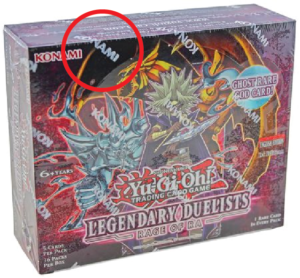
Step 2: Red flags to look for
Most counterfeit trading card products come from China, which often results in translation issues printed on the box, lower quality packaging, and of course, poorly faked cards. In addition to this, purchasing products from sites like Wish or Aliexpress is very risky and has a high likelihood of being scammed.
If you are suspicious of a booster box, the first thing to do is check for these red flags:
- Misaligned booster packs (upside down)
- Spelling mistakes
- Grammatical errors
- Low-resolution images
- Loose plastic wrap
- Cheap purchase price
Step 3: Compare to authentic booster boxes
If you have nothing to compare it to, a fake booster box might seem authentic. Luckily, a quick Google search is all you need. Below is an image submitted by one of our readers, Purich, who suspected that their Yu-Gi-Oh! booster box may be fake.

You can see that the pack artwork does not match the box. A quick search on eBay for “YuGiOh Shadow Specters booster box” produced multiple listings of the authentic box:

Type into Google the set name on the front of your booster box. For example, “Battle of Chaos” followed by “booster box”. And that’s all you need. The majority of search results are going to bring up authentic products. Compare your box to the rest.
To double-check, search for your booster box on eBay. eBay is very good at filtering out fake products. Beware, fakes are on eBay, but most listings will be authentic.
Look through the eBay listings until you find a reputable seller with plenty of 5-star reviews and compare your booster box to images of theirs. If you find any of the red flags listed earlier, your box is unfortunately fake.
Step 4: Consider all other factors
If you’re still not sure if your booster box is fake or not, take a step back and consider why you even had to Google “How to tell if a YuGiOh booster box is fake”.
Where did you get it from?
If you bought the product from a flea market, a cheap website (Wish, AliExpress), or a second-hand market (Facebook Marketplace, Craigslist) then you’ve unfortunately positioned yourself to be scammed.

How much did you pay?
Prices vary between sets since some have rare cards than others, but they are never dirt cheap. If the price is very low, then use good judgment.
The old saying is: if it’s too good to be true, it probably is.
YuGiOh booster boxes tend to hover around the $100usd mark. As we mentioned before, it varies, but you’ll never find an authentic one for $20-$40.
What to do if you purchased a fake booster box
Step 1: Verify that it is fake
This can be done by carefully comparing your box to photos of authentic ones on eBay. If you’re still unsure, stop by a local games store and ask the experts. Another option is to take photos and post them to a Yu-Gi-Oh! Group on social media, asking for confirmation.
Step 2: Contact the seller
If the seller was genuinely unaware that the booster box is fake, they may offer a refund. In this scenario, it can help to show them all the evidence you have, and make sure to link them this article. eBay is very good about this, almost always issuing refunds quickly and without question.
Unfortunately, if the seller is a scammer then you are probably out of luck, in which case you can contact the customer support of the website if you bought it online.
Step 3: Open a dispute
Most websites would have customer support. Check the footer (scroll all the way to the bottom of the page) and look for a help, contact, or support link. Wish and AliExpress will usually not have a problem refunding you.
If you used eBay, the seller might ask for a return. In this case, you’ll have to send the product back. It’s important to go through eBay’s return process and make sure you take a video of yourself dropping the package off. When you ship it out, make sure you pay extra for tracking.
Step 4: Educate others
Sometimes you win, sometimes you lose. Whether or not you get your money back, it’s now your responsibility to step in and help others when you see a similar situation unfolding. Share your experience on any relevant social media pages you follow and maybe you’ll save someone from getting scammed in the future. Share this article if you want to help the fight against Yu-Gi-Oh! Card scammers.
Conclusion
This is the reality of being a trading card fan. In this hobby it’s not uncommon to get scammed, whether its over a few bucks or a big purchase, it happens a lot.
Only buy from reputable sellers. Try to purchase through local game shops, or use 5-star sellers on eBay. Before you pull the trigger, double-check the images and listing, are there spelling errors? When the package finally arrives, film yourself opening it. If it’s fake, you’ll then have hard cold proof.
